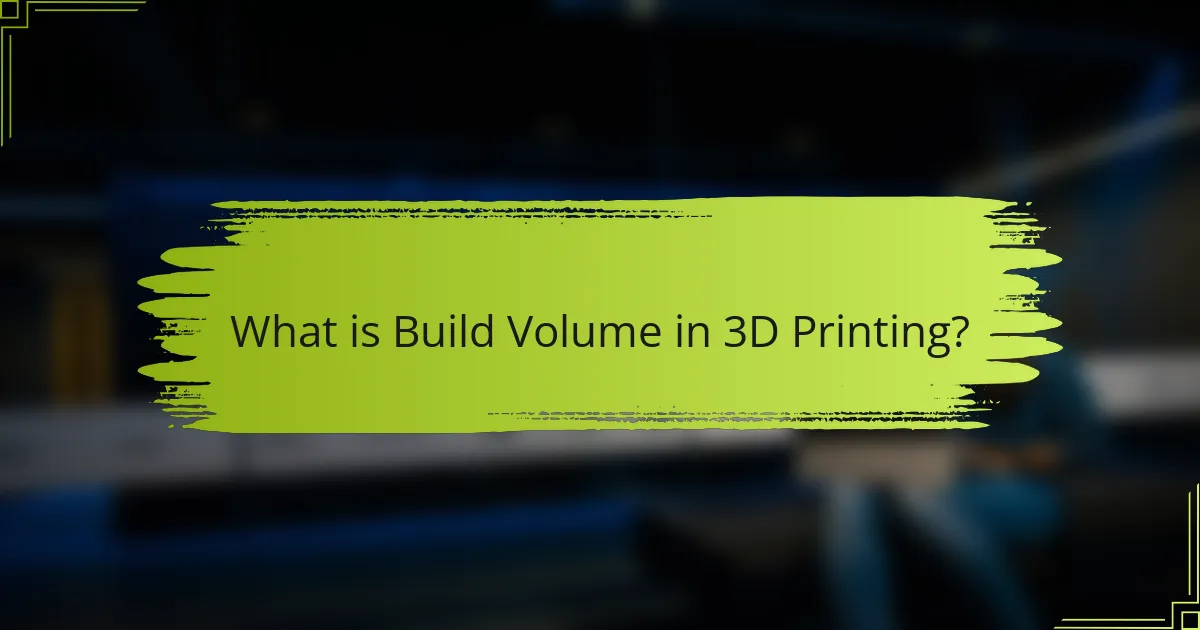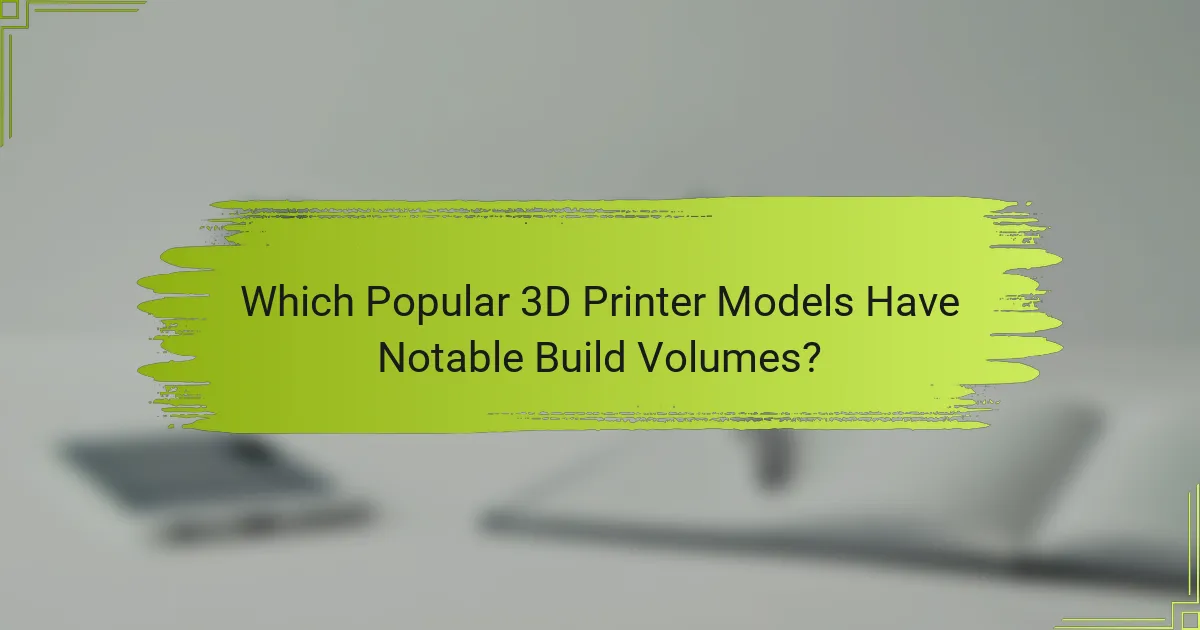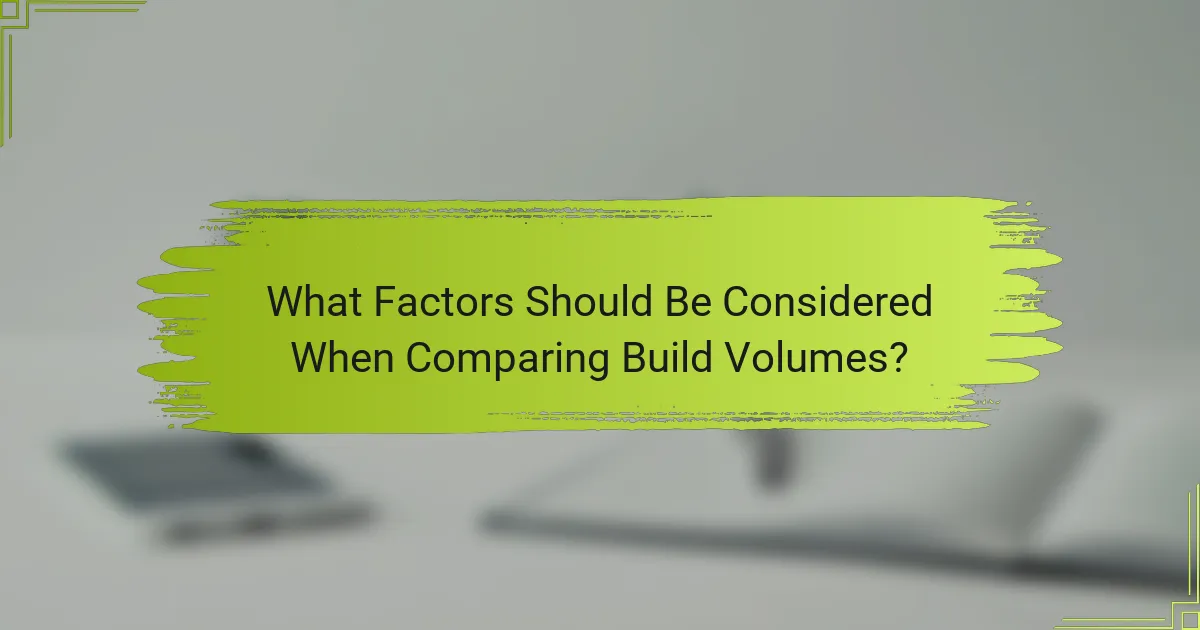
What is Build Volume in 3D Printing?
Build volume in 3D printing refers to the maximum size of an object that a 3D printer can produce. It is typically defined by three dimensions: width, depth, and height. For example, a printer with a build volume of 200mm x 200mm x 200mm can create objects that fit within these dimensions. This measurement is crucial for determining the types of projects a printer can handle. Larger build volumes allow for bigger prints or multiple smaller prints in one session. The build volume varies significantly across different 3D printer models, influencing their suitability for various applications. Understanding build volume helps users select the right printer for their specific needs.
How is Build Volume Defined in 3D Printers?
Build volume in 3D printers is defined as the maximum space available for printing an object. This space is usually measured in three dimensions: width, depth, and height. Each printer model has a specific build volume that dictates the size of objects it can create. For example, a printer with a build volume of 200mm x 200mm x 200mm can print objects up to that size. Understanding build volume is crucial for selecting a printer for specific projects. It determines the feasibility of printing larger designs without modifications. The build volume also impacts the printing speed and material usage. Manufacturers often specify build volume in their product descriptions to aid consumer choice.
What are the standard measurements for Build Volume?
The standard measurements for build volume in 3D printers are typically expressed in cubic centimeters (cm³) or cubic inches (in³). Common dimensions include width, depth, and height, measured in millimeters (mm) or inches. For example, a standard build volume might be 200 mm x 200 mm x 200 mm. This means the printer can create objects up to 20 cm in each dimension. Many consumer 3D printers have build volumes ranging from 100 mm to 300 mm on each axis. Larger industrial models can exceed these dimensions significantly. The build volume directly impacts the size of the objects that can be printed. Therefore, understanding these measurements is crucial for selecting a 3D printer that meets specific project needs.
How does Build Volume impact printing capabilities?
Build volume directly impacts the size and complexity of objects that can be printed. A larger build volume allows for the creation of bigger models without needing to split them into smaller parts. This capability is essential for industries that require large prototypes or components, such as automotive and aerospace. Conversely, a smaller build volume limits the size of the printed objects, which can restrict design possibilities. For instance, a printer with a build volume of 300x300x400 mm can produce significantly larger items than a printer with a 200x200x200 mm build volume. Additionally, larger build volumes can accommodate more intricate designs that require additional space for support structures. Thus, the build volume is a critical factor influencing the versatility and application of 3D printers.
Why is Build Volume Important for 3D Printing?
Build volume is crucial for 3D printing because it determines the maximum size of objects that can be printed. A larger build volume allows for the creation of bigger and more complex designs. It also enables the printing of multiple smaller items simultaneously, improving efficiency. For instance, a printer with a build volume of 300 x 300 x 400 mm can accommodate larger prototypes compared to one with a 200 x 200 x 200 mm volume. This capability is essential for industries like automotive and aerospace, where larger parts are often required. Additionally, a suitable build volume can reduce the need for assembly by allowing larger components to be printed in one piece. Overall, build volume directly impacts the versatility and application range of a 3D printer.
What are the advantages of larger Build Volumes?
Larger build volumes in 3D printers offer significant advantages. They allow for the creation of larger parts in a single print. This reduces the need for assembly, saving time and effort. Larger volumes also enable more complex geometries that would otherwise require multiple prints. This capability enhances design flexibility for various applications. Additionally, larger build volumes can accommodate larger projects, increasing productivity. According to a study by Wohlers Associates, larger build volumes are essential for industrial applications, improving efficiency in manufacturing processes.
How does Build Volume influence design flexibility?
Build volume directly influences design flexibility by determining the maximum size of objects that can be printed. A larger build volume allows for the creation of bigger and more complex designs. It enables designers to incorporate intricate details and multiple components in a single print. This capability reduces the need for assembly, streamlining the production process. Conversely, a smaller build volume limits the dimensions of the printed objects. This constraint can necessitate the division of larger designs into smaller parts, which may affect structural integrity and aesthetics. Therefore, the build volume is a critical factor in the overall design process for 3D printing.

Which Popular 3D Printer Models Have Notable Build Volumes?
Popular 3D printer models with notable build volumes include the Creality CR-10, Prusa i3 MK3S+, and Anycubic Chiron. The Creality CR-10 features a build volume of 300 x 300 x 400 mm. The Prusa i3 MK3S+ offers a build volume of 250 x 210 x 210 mm. The Anycubic Chiron has an impressive build volume of 400 x 400 x 450 mm. These models are recognized for their ability to print larger objects. They are widely used in both hobbyist and professional settings. Their build volumes make them suitable for various applications, including prototyping and custom projects.
What are the top 3D printers currently available?
The top 3D printers currently available include the Prusa i3 MK3S+, the Creality Ender 3 V2, and the Anycubic Vyper. The Prusa i3 MK3S+ is known for its reliability and high-quality prints. It features a build volume of 250 x 210 x 210 mm. The Creality Ender 3 V2 offers an affordable option with a build volume of 220 x 220 x 250 mm. The Anycubic Vyper provides automatic bed leveling and a build volume of 245 x 245 x 260 mm. These printers are recognized for their performance and user-friendly features.
How do different models compare in terms of Build Volume?
Different 3D printer models exhibit varying build volumes. For instance, the Creality Ender 3 has a build volume of 220 x 220 x 250 mm. In contrast, the Prusa i3 MK3S offers a larger build volume of 250 x 210 x 210 mm. The Anycubic Mega-S features a build volume of 210 x 210 x 205 mm, which is smaller than the Ender 3. Meanwhile, the Ultimaker S5 boasts an extensive build volume of 330 x 240 x 300 mm. This comparison indicates that higher-end models typically provide larger build volumes, enabling more complex prints. Each model’s specifications reflect its intended use and target audience.
What unique features do these models offer related to Build Volume?
Certain 3D printer models offer unique features that enhance their build volume capabilities. For instance, some models utilize a modular design, allowing users to expand the build area by adding additional sections. This feature enables the printing of larger objects without compromising quality. Other models incorporate advanced motion systems, such as CoreXY or delta configurations, which can optimize the print area while maintaining speed and precision. Additionally, specific models feature a heated build platform that can accommodate larger prints by improving adhesion and reducing warping. These enhancements contribute to the versatility and efficiency of the 3D printing process, making them suitable for various applications.
How do Build Volumes Vary Among Different Printer Types?
Build volumes vary significantly among different types of 3D printers. FDM printers typically have smaller build volumes, often ranging from 200x200x200 mm to 300x300x400 mm. In contrast, SLA printers generally offer smaller build volumes, usually around 120x120x150 mm to 200x200x250 mm. DLP printers can have similar or slightly larger volumes compared to SLA, depending on the model. Industrial 3D printers, such as SLS or metal printers, can achieve much larger build volumes, often exceeding 600x600x600 mm. These variations are due to the different technologies and intended applications of each printer type. For instance, FDM printers are designed for prototyping, while industrial printers focus on production.
What are the differences in Build Volume between FDM and SLA printers?
FDM printers typically have larger build volumes than SLA printers. FDM printers can often print objects ranging from 200 mm to 300 mm in width, depth, and height. In contrast, SLA printers usually have smaller build volumes, often around 120 mm to 200 mm. The larger build volume in FDM allows for more significant and complex prints. This difference is due to the design and technology of each printer type. FDM uses a filament that is extruded layer by layer, enabling larger dimensions. SLA, on the other hand, uses a resin that is cured layer by layer, which limits its size capabilities.
How do industrial 3D printers compare to consumer models in Build Volume?
Industrial 3D printers typically have a larger build volume compared to consumer models. For instance, industrial printers can offer build volumes exceeding 1 meter in each dimension. In contrast, most consumer models have build volumes ranging from 200 mm to 400 mm on average. This significant difference allows industrial printers to produce larger parts or multiple smaller parts simultaneously. The larger build volume in industrial models accommodates complex projects that require extensive material and design. Manufacturers like Stratasys and EOS illustrate this with their industrial models featuring expansive build areas. Such capabilities make industrial printers more suitable for applications in manufacturing and prototyping.

What Factors Should Be Considered When Comparing Build Volumes?
When comparing build volumes, several factors should be considered. The dimensions of the printer’s build area are crucial. These dimensions determine the maximum size of the objects that can be printed. Additionally, the shape of the build volume matters. Some printers have rectangular volumes, while others may be cylindrical or have unique shapes.
The printer’s technology also influences build volume. Different 3D printing technologies, such as FDM or SLA, may have varying capabilities in terms of build size. Material constraints can affect the maximum build volume as well. Certain materials may require specific settings that limit the feasible build dimensions.
The printer’s stability and design also play a role. A stable printer can handle larger volumes without compromising print quality. Finally, the intended use of the 3D printer should be considered. Different applications may require different build volumes for optimal performance.
How does the intended application affect Build Volume selection?
Intended application significantly influences Build Volume selection. Different applications require varying sizes and complexities of printed objects. For example, large-scale prototypes or architectural models need a larger build volume. In contrast, detailed miniatures or small parts can be printed in smaller volumes. Additionally, industrial applications often demand larger volumes for efficiency. Conversely, hobbyist projects may prioritize detail over size. Thus, understanding the specific application helps in choosing the right build volume for optimal results.
What role does material choice play in Build Volume considerations?
Material choice significantly influences build volume considerations in 3D printing. Different materials have varying physical properties, which can affect how they perform within a given build volume. For instance, some materials may require specific temperature settings, impacting the maximum size of the print. Additionally, the density of the material can determine the structural integrity of larger prints.
Certain materials, like PLA, are easier to work with and can be printed in larger volumes without warping. In contrast, materials such as ABS may require more precise conditions and can limit the effective build volume due to warping tendencies. Furthermore, the choice of material can affect the printer’s settings, such as nozzle size and layer height, which in turn impacts the maximum achievable dimensions of a printed object.
For example, a study by Huang et al. (2018) published in the Journal of Manufacturing Processes indicates that the choice of filament directly influences the dimensional accuracy and stability of prints, thereby affecting the practical build volume. Thus, material choice is a critical factor in determining the effective build volume in 3D printing.
How does printer technology impact Build Volume capabilities?
Printer technology significantly influences build volume capabilities. Different technologies, such as Fused Deposition Modeling (FDM) and Stereolithography (SLA), have distinct limitations and advantages. FDM printers typically allow for larger build volumes due to their simpler mechanics and open-frame designs. In contrast, SLA printers often have smaller build volumes due to the constraints of their resin tanks and curing processes.
Additionally, advancements in printer technology, such as the introduction of larger print heads or improved motion systems, can increase build volume. For example, some high-end FDM models now feature dual extrusion capabilities, which can enhance efficiency in larger prints.
Moreover, the materials used in each technology can also affect build volume. FDM printers can accommodate various filament sizes, while SLA printers are limited to specific resin types. Therefore, printer technology directly determines the maximum dimensions of objects that can be printed, influencing both the scale and complexity of projects.
What are the common misconceptions about Build Volume?
Common misconceptions about build volume include the belief that larger build volumes always equate to better printer performance. This is inaccurate, as print quality depends on various factors, not just size. Another misconception is that build volume is the only consideration for large prints. In reality, printer design, stability, and material compatibility also play crucial roles. Some users think that a printer’s maximum build volume can be fully utilized without restrictions. However, certain designs may limit the effective build area due to structural components. Additionally, many believe that all printers with the same build volume produce identical results. This is false, as differences in nozzle size and layer resolution can affect print outcomes. Lastly, some assume that increasing build volume significantly raises the cost. While this can be true, many budget-friendly options exist that offer larger volumes without a steep price increase.
Why is bigger not always better in terms of Build Volume?
Bigger build volume in 3D printers is not always better due to several factors. Increased size can lead to longer print times, which may not be efficient for smaller projects. Larger printers often require more complex calibration and maintenance. The risk of print failures also increases with larger volumes, leading to wasted materials and time. Additionally, larger printers may have limitations in terms of stability and precision. A study from the Journal of 3D Printing Technology shows that print quality can diminish as build volume increases. Thus, while a larger build volume offers more flexibility, it can compromise efficiency and quality in certain scenarios.
How can users effectively assess their Build Volume needs?
Users can effectively assess their Build Volume needs by evaluating the dimensions of their intended projects. They should measure the largest dimensions of the objects they plan to print. This includes height, width, and depth. Users can also consider the types of materials they will use, as some materials may require specific configurations. Additionally, users should analyze the complexity of their designs, as intricate models may need more space. Reviewing existing 3D printer specifications can provide insight into common Build Volume sizes. Users should also account for future projects to avoid limitations. By understanding their specific requirements, users can select a 3D printer with an appropriate Build Volume.
What Tips Can Help Users Optimize Their 3D Printing Experience?
To optimize their 3D printing experience, users should calibrate their printers regularly. Proper calibration ensures accurate dimensions and enhances print quality. Users should also select the right filament for their specific printer model. Different filaments have varying temperature requirements and adhesion properties. Maintaining a clean print bed is crucial for successful prints. A clean surface helps prevent warping and improves adhesion. Users should also monitor print settings like layer height and speed. Adjusting these settings can lead to better detail and surface finish. Additionally, utilizing supports and rafts can help complex designs print more effectively. These tools provide stability during the printing process. Finally, users should keep their printers updated with the latest firmware. Updates can improve performance and fix bugs, enhancing the overall experience.
The main entity of the article is the build volume in 3D printing, which refers to the maximum dimensions of objects that a 3D printer can produce. The article provides a comprehensive guide comparing the build volumes of various popular 3D printer models, highlighting their specifications and implications for printing capabilities. It discusses how build volume impacts design flexibility, printing efficiency, and material usage, while also addressing factors such as printer technology and intended applications. Additionally, the article clarifies common misconceptions about build volume and offers tips for users to assess their needs effectively.